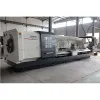- Beauty & Personal Care
- Business Services
- Chemicals
- Construction & Real Estate
- Consumer Electronics
- Electrical Equipment & Supplies
- Electronic Components & Supplies
- Energy
- Environment
- Excess Inventory
- Fashion Accessories
- Food & Beverage
- Furniture
- Gifts & Crafts
- Hardware
- Health & Medical
- Home & Garden
- Home Appliances
- Lights & Lighting
- Luggage, Bags & Cases
- Machinery
- Measurement & Analysis Instruments
- Mechanical Parts & Fabrication Services
- Minerals & Metallurgy
- Office & School Supplies
- Packaging & Printing
- Rubber & Plastics
- Security & Protection
- Service Equipment
- Shoes & Accessories
- Sports & Entertainment
- Telecommunications
- Textiles & Leather Products
- Timepieces, Jewelry, Eyewear
- Tools
- Toys & Hobbies
- Transportation
What is pipe threading lathe machine?
A pipe threading lathe machine is a specialized piece of equipment used in metalworking and machining operations to create threads on cylindrical surfaces of pipes or tubing. These machines are specifically designed to perform precision threading tasks, such as cutting external or internal threads, taper threads, and other thread profiles, on pipes of various diameters and lengths.
The pipe threading lathe machine typically consists of several key components:
Bed and Headstock: The bed is the main structural component of the threading lathe machine, providing support and rigidity. The headstock is mounted on the bed and houses the main spindle, which holds the workpiece (the pipe) securely in place during threading operations.
Lead Screw and Gearbox: The lead screw is responsible for driving the cutting tool along the length of the workpiece to create threads. The gearbox allows for the adjustment of thread pitch and speed, enabling the operator to achieve precise threading results.
Cutting Tool Holder: The cutting tool holder securely holds the cutting tool in place and allows for precise positioning and adjustment. Different types of cutting tools can be used depending on the desired thread profile and material of the workpiece.

Unwrapping the Baling Machine: Your Comprehensive Guide to Quality, Cost-Effectiveness, Innovation, and Sustainability?
What are the top tips for maximizing savings with the Pallet Inverter E Series Archive?
Is Towing Agv the Best Investment for Your Business?
Unveiling the Ultimate Guide to SMD Transistor Packages
Top Box Turning Conveyor Belt Exporters: Solving Your Material Handling Needs
Revolutionizing the Conveyor Rejection System: A Gamechanger?
Revolutionizing Production with Advanced Smt & Through Hole Assembly Techniques: Are Traditional Methods Obsolete?
Tailstock: The tailstock provides additional support for longer workpieces and helps to ensure concentricity during threading operations. It can be adjusted to accommodate pipes of different lengths and diameters.
Chuck or Clamping Mechanism: A chuck or clamping mechanism is used to securely grip the workpiece (the pipe) in place during threading operations. It ensures that the pipe remains stable and centered as the cutting tool moves along its length.
Control Panel: The control panel houses the controls and interface for operating the machine. Operators can adjust parameters such as thread pitch, cutting depth, and spindle speed to achieve the desired threading results.
CNC Pipe threading lathe machines come in various configurations and sizes to accommodate different pipe diameters, lengths, and thread specifications. They are commonly used in industries such as plumbing, construction, oil and gas, and manufacturing, where threaded pipes are essential components of pipelines, plumbing systems, and machinery.
Overall, pipe threading lathe machines play a crucial role in the production of accurately threaded pipes, ensuring tight seals, proper fit, and efficient assembly in a wide range of applications.
Revolutionizing Production Efficiency with Buffer Storage?
What Are the Different SMD Transistor Types?
Understanding SMD Packages: The Ultimate Guide
Ozonia Ozone Generator Systems for Water Treatment
How Does a Surface Mount Device Work?
Surface Mount Technologies vs Traditional Through-Hole: A Comparison
Everything you need to know about Component Package Types
Related Articles
If you are interested in sending in a Guest Blogger Submission,welcome to write for us!









![What is the SMT Manufacturing Process [Step by Step]](https://images.techoeidm.com/upload/collect_article/20240520/e4d3e8b9b6617f3597586a753a0dbafe.png)


Comments
0